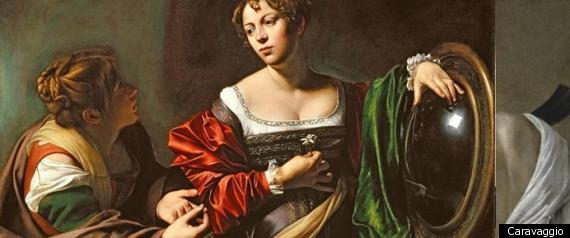Simon Schama in his brilliant BBC series "The Power of Art" first introduced me to the Italian artist Caravaggio. Michelangelo Merisi da Caravaggio's use of light in his paintings could only be compared to modern dramatic movie lighting and his patrons were among the highest ranking Cardinals at the Vatican. At the time of his death at the tender young age of 38 he was an outlaw on the run, wanted for murder.
He was a hot head lunatic who was easily prone to violence, roaming the rough and tumble streets of 17th century Rome wielding a sword and dagger shouting down anyone who challenged him "I'll cut off your balls and fry them in oil!" He frolicked late at night in taverns drinking with swordsmen, hustlers, whores and pimps but he was also intensely Christian and had a deep belief in the redemptive healing powers of Christ. He was a savage sinner who painted the most heartbreakingly real life scenes of the bible's most dramatic events. He used prostitutes and street people as his models and portrayed biblical events to be the thuggish streets crimes that some of them were.

The exhibit "Caravaggio and his followers in Rome" is on now through January 8 at the Kimbell Art Museum in Ft. Worth, TX. There are only 10 actual Caravaggio paintings on display but it is well worth the $14 general admission just to stand in front of Caravaggio's work once in your life. The former cow town of Ft. Worth now hosts some of Caravaggio's most stunning work. "Sacrifice of Isaac" depicts Abraham about to prove his devotion to God by slitting the throat of his son Isaac when a winged angel steps in to intervene. Unlike any other painting you have ever seen of this event Isaac is screaming his head off in terror.

In 'Saint Francis in Ecstasy' you can feel St. Francis tremble as a young boyish angel with white puffy wings gently props him up. Caravaggio's Saint John the Baptist is depicted as a brooding young seductive half naked teen boy wrapped delicately in crimson clothe as he twiddles his walking stick in "Saint John the Baptist in the Wilderness." "Boy Bitten by a Lizard" is so startlingly fantastic you almost want to burst out into laughter when your eyes see it from the handsome young man recoiling from his finger being pricked. 'Sick Bacchus' is the sickly self portrait Caravaggio did of himself as the Greek God of wine Bacchus, and proof that the artist was not concerned with following any rules of convention.
"The Gypsy Fortune Teller" is of an alluring Gypsy girl sensuously stroking the hand of her well dressed patron as unbeknownst to him she is removing his ring. 'The Cardsharps' is the painting that first made Caravaggio a star in Rome and attracted his first most faithful followers. The painting depicts a fresh faced rosy cheeked young man in a tavern card game as his opponent is being signaled by another man what cards the young rube is holding while pulling stronger cards from his breeches. This painting alone warrants hours of staring. In this one still image scene I feel more emotion and believable plot than I've seen in 100 Hollywood movies. Loss of innocence is a recurring theme in Caravaggio's work .

I believe his art is so accessible for people living in today's world because, as much as we would all like to think that we are each sovereign entities living with certain autonomy, we are all susceptible to being swindled. Much too much has been written about Caravaggio speculating whether or not he was homosexual, considering the amount of handsome young male flesh he captured on canvas I think it is beyond speculation. For me his fruit is far more memorable. His fruit is so true to life it seems to throb on the canvass. Even in the dirty finger nail hands of "Sick Bacchus" his rancid grapes are so foul and lifelike you can easily envision real life flies swarming around them. Caravaggio's work still speaks to us today because he believed in the real life of his street urchin companions enough to capture their poignant angst and suffering to move any eyes that would ever be cast upon them.

The people in his paintings are people we see every day and could be any one of us. They are real life humans not super natural angels surrounded with heavenly white doves being bathed in celestial light. His paintings survive the test of time because they portray life to be the dirty bitch that it sometimes is. Caravaggio had many followers and imitators but none could match the intensity of his story telling, the total wickedness with which he lived his life and the cruel reality of life that he captured on canvas.
There is a limited amount of time left for you to witness this once in a lifetime exhibit of true genus. Get to Ft. Worth, TX before January 8th.